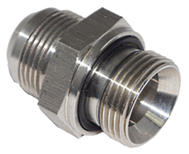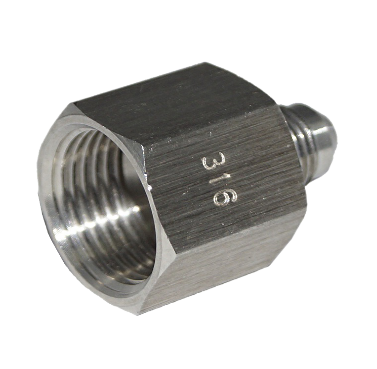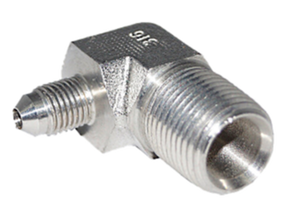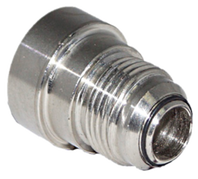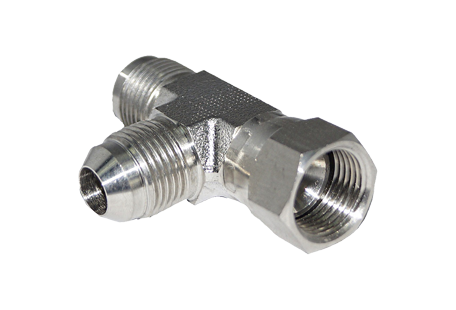|
|
JIC Fittings are a form of hydraulic fittings designed following the SAE J514 and ISO 8434-2. The JIC acronym represents Joint Industry Council and the JIC Fittings are used in a variety of industries, especially in high pressure systems. The fittings are also known as JIC 37 degrees flare fitting because the fitting is designed with 37 degrees to flare seating surfaces. The fitting has three parts – flare nut, sleeve, and fitting body. JIC Fittings are produced in different sizes ranging from 1/4” to 1 1/2”. Further, the fittings are made of Stainless Steel SS316 and Carbon Steel. The standard working pressure for the JIC Fittings is measured between 1000 PSI to 5000 PSI. JIC Fittings ensure the connection of tubes of different sizes is securely sealed. |
Material Specification |
|
Connection Type |
|
Size |
|
Working Pressure |
|
1. What are JIC Fittings?
|
JIC Fittings are mostly used in a fluid power system where transmission and control of power occur through a pressured fluid. Also, they are used in other systems working under high pressure. Most fittings are designed to work with and correlate with tubing outer diameter (OD). Particularly, JIC fittings are connectors of metric and inch tube sizes. The connection of fittings to pipes is made using sleeves and nuts.
JIC Fittings are made following SAE J514 and ISO 8434-2 standards and produced in size ranging from 1/4” to 1 1/2”. The complete set of a JIC Fitting consists of a sleeve, body, and nut with the body seating surface designed with a 37-degree flare. The JIC fitting can withstand a maximum working pressure of 420 bars and fit for different industries. |
2. What is 37-degree flared used for?
|
Flare fittings are types of compression fittings used to connect metal, copper, aluminum tubes. They are used mostly with a copper tube or natural gas systems. Flare fittings are made in different standards, however, the common standards are 45⁰ SAE flare, 35⁰ AN flare, and 37⁰ JIC flare.
The JIC fitting body without the nut and sleeve can serve as a hose adapter fitting used to connect a female adjustable swivel end during a hose assembly installation. The sleeve and body can fit in any measurements, either metric or inches, however, the nut has to be compatible with the tube's size to be used. |
3. What are the differences between JIC and NPT?
|
For the connection of tubes, hoses, and pipes, there are different connection types or threads available based on the design of the system. Some of these are British Standard Parallel Pipe (BSPP), National Pipe Thread (NPT), Joint Industry Council (JIC), ASME, etc. JIC is designed with a 37-degree flare for attachment to hoses or flared tubes. While manufacturing tubes, a process called forging is done. During forging, metal is shaped into desired shapes using compressing forces. Tube flaring is a forging for the metals using a cold working process. JIC threads are specifically designed to be used in high pressure systems.
NPT threads are one of the oldest connection threads used. They are designed to be used in low pressure systems. Often, they are used to connect ports, tubes, and pipes in hydraulic systems. |
The table below shows the major differences between the two threads:
|
4. How can JIC Fittings affect temperature rating?
JIC Fittings are made from stainless steel SS316L and Brass and Carbon Steel. The surface of the fitting is protected against contamination for higher corrosion resistance. The table below shows the temperature rating for each material:
Material |
Surface Protection |
Temperature Rating |
Acid Cleaning |
-45 ⁰C – 175 ⁰C |
|
White Zinc Plating |
-60 ⁰C – 200 ⁰C |
|
Passivation |
-60 ⁰C – 200 ⁰C |
|
Another factor that can affect the overall temperature rating of the system is Seal material. The standard sealing material used is the NBR O-ring seal. Here’s a table showing the temperature rating for each material:
|
5. How do I know JIC Fitting size?
There are different types of readings for JIC Fitting Sizes. For United States users or buyers, Dash size is a number used to allow easy identification of components. It is indicated using a numerator and denominator, where the numerator is the size and the denominator is always 16.
Please refer to the table below for the size (dash and tube):
Please refer to the table below for the size (dash and tube):
|
6. How do you tighten a JIC Fitting?
|
STEP 1
Inspect the fitting surface and sealing surface for any contamination or damage. Thereafter, measure the tube to the desired length and flare to 37 degrees. STEP 2 Use a lubricant like a hydraulic fluid on the flare and threads' entire surface. STEP 3 Place the nut and sleeve in the tube end connection. Position the components well before hand tightening. Then, turn the flare nut to reach the sealing surface. STEP 4 Verify the tighten torque numbers and ensure the requirements are met. |
JIC fittings CATALOGUE

